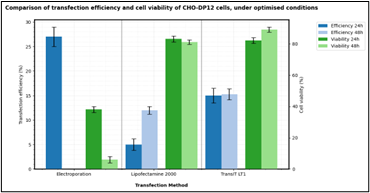Paper Authors and Title
Luke Gallagher (Atlantic Technological University), Eva Campion, “Optimisation of CHO-DP12 transfection using Lipofectamine 2000, TransIT LT1 and electroporation”
Abstract
Chinese hamster ovarian cells are a staple of biopharmaceuticals, with over 70% of approved recombinant-proteins utilising this system. The development of robust and effective cell-lines is time consuming and expensive and there is a need for improved transfection methods in CHO-cells.
We evaluated three transfection methods: Lipofectamine 2000, TransIT LT1, and electroporation under specific conditions. For Lipofectamine 2000, we considered reagent:DNA ratios of 2:5 to 1:1, cell concentrations ranging from 5×104 to 2x105cells/ml, and 4-7µg of DNA. For TransIT LT1, the ratios were 2:1 to 5:1, cell concentrations varied between 5×104 and 5×105 cells/ml, and 2-5µg DNA. For electroporation, we employed voltages between 200V and 260V.
Lipofectamine (reagent/DNA ratio 2:5, 2x105cells/ml, 5µg DNA) and TransIT transfections (reagent/DNA ratio 3:1, 2x105cells/ml, 5µg DNA) were successful, with peak efficiencies of 12% and 15%, respectively. No significant decrease in viability was observed in all TransIT LT1 conditions; however, Lipofectamine showed a significant decrease in viability using reagent:DNA ratios 4:5 and 1:1. Electroporation resulted in 25% transfection efficiency, but this was lost 48h post-transfection and a significant decrease in viability was observed.
While these results indicate TransIT may be the more effective reagent for CHO-DP12 transfection, further experimentation is required. Future studies should examine complex incubation times and media formulation. Additionally, challenges with the operation of the electroporator, prevented its accurate assessment. However, the inexpensive and procedurally simple method offered by Lipofectamine and TransIT, could accelerate the development of recombinant biopharmaceuticals, and ultimately reduce the cost to the patient in a hyperinflated medical sector.
Figure 1. Comparison of transfection efficiency and cell viability in CHO-DP12 cells using optimized conditions. Conditions: Lipofectamine 2000 (2:5 reagent/DNA ratio, 2×105 cells/ml, 5µg DNA), TransIT LT1 (3:1 reagent/DNA ratio, 2×105 cells/ml, 5µg DNA), and electroporation (260V, 2×105 cells/ml, 5µg DNA).

